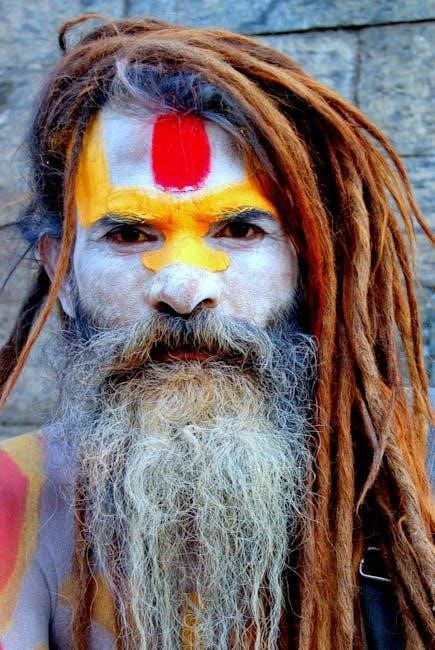A beard fade is a stylish grooming technique where the beard hair gradually transitions from longer to shorter lengths, creating a seamless blend․ It’s a popular choice for men seeking a modern, polished look that enhances facial features and suits various face shapes and personal styles․
1․1 What is a Beard Fade?
A beard fade is a grooming technique where the beard hair is gradually reduced in length, creating a smooth transition from the temples to the jawline․ It involves using clippers with adjustable guards to blend the hair seamlessly, resulting in a clean, defined look․ This style enhances facial features and offers a modern, polished appearance, making it a versatile choice for various face shapes and personal preferences․
1․2 Importance of Beard Fades in Grooming
Beard fades are essential in modern grooming as they offer a sleek, polished appearance that enhances facial symmetry․ By creating a seamless transition from hair to skin, fades eliminate harsh lines, making the beard look more defined and well-maintained․ This technique is particularly effective for men with uneven hair growth or patchy beards, as it creates a balanced look․ Additionally, a well-executed fade can elevate a man’s style, making it a key component of contemporary grooming routines․

Understanding Beard Fade Styles
Beard fade styles offer a variety of options to suit different preferences and face shapes․ From subtle transitions to dramatic contrasts, these styles enhance a man’s appearance by creating a polished look․ Understanding the types of fades, such as high, low, taper, and skin fades, allows individuals to choose a style that complements their facial features and personal grooming goals, ensuring a tailored and modern aesthetic․
2․1 Popular Types of Beard Fades
Among the popular beard fade styles are the high fade, low fade, taper fade, and skin fade․ Each offers a distinct look, catering to various preferences and face shapes․ The high fade creates a bold contrast by fading hair close to the temple, while the low fade provides a subtle transition near the jawline․ The taper fade blends hair naturally, and the skin fade removes all hair for a sleek, modern appearance․ These styles are versatile and can be tailored to individual grooming goals․
2․2 Choosing the Right Fade for Your Face Shape
Choosing the right beard fade depends on your face shape․ Oval faces can pull off most styles, while round faces benefit from high fades to elongate․ Square faces look best with low fades to soften angles, and triangular faces suit taper or skin fades to balance proportions․ Consider your features to select a fade that enhances symmetry and complements your natural look for a polished, tailored appearance․

Tools and Preparation
Essential tools for a beard fade include clippers, trimmers, scissors, and a comb․ Properly preparing your beard with even length and clean lines ensures a smooth transition and professional finish․
3․1 Essential Tools for a Beard Fade
To achieve a perfect beard fade, you’ll need specific tools․ Start with a good pair of clippers, preferably adjustable ones for varying lengths․ A trimmer is essential for detailing and creating sharp lines around the edges․ A fine-tooth comb helps in sectioning and guiding the clippers accurately․ Scissors can be useful for trimming stray hairs, especially in harder-to-reach areas․ A mirror is crucial for visibility, and a clean cape or towel will keep your workspace tidy․ Using high-quality tools ensures precision and a professional finish, making the process easier and more efficient․ Proper tool maintenance, like keeping blades sharp and clean, is also key to avoiding uneven cuts and skin irritation․ By gathering all necessary tools beforehand, you set yourself up for success and a smooth experience․
3․2 Preparing Your Beard for the Fade
Before creating a beard fade, properly prepare your beard․ Start by washing and drying your beard to remove any oils or tangles․ Use a trimmer to even out the length, ensuring consistency across all areas․ Section your beard, clipping the top portion away to focus on the lower parts first․ This helps maintain symmetry and makes the fading process more manageable․ A clean, well-prepared beard allows for better control and precision when fading, leading to a smoother, more professional result․

Step-by-Step Guide to a Perfect Beard Fade
Mastering a beard fade requires precision and patience․ Start by sectioning your beard and trimming evenly․ Use a trimmer with guards to create gradual transitions, blending from short to long lengths seamlessly․ Focus on symmetry and natural lines, ensuring smooth edges and a defined shape․ Clean up stray hairs and blend the fade for a polished finish that enhances your overall look and style․
4․1 Trimming and Sectioning the Beard
Begin by washing and towel-drying your beard to ensure even trimming․ Use a comb to section the beard into manageable parts, starting from the cheeks and working down․ Clip the top sections away to focus on the lower areas first․ With a trimmer, start at the lowest guard size and gradually increase, following the natural curve of your jawline․ This method ensures a balanced and symmetrical base for the fade, making the blending process smoother and more precise․
4․2 Creating the Fade Transition
Start by identifying where you want the fade to begin, typically at the temple or cheekbone․ Use a trimmer without the comb attachment to create a defined edge․ Work in small increments, gradually decreasing the guard size as you move downward․ This technique ensures a smooth, natural-looking transition․ Use light, steady strokes to blend the hairline seamlessly into the skin, maintaining consistency on both sides for a professional finish․ This step is crucial for achieving the desired fade effect․
4․3 Blending the Fade for a Natural Look
Once the fade transition is created, use a trimmer without the comb attachment to feather the edges․ Gently blend the hairline by making small, light strokes upward and downward․ This ensures the fade appears seamless and natural․ Check your progress in a mirror, adjusting as needed․ To enhance the blend, use a razor or detail trimmer to tidy up stray hairs and define the edges․ Proper blending is key to achieving a polished, professional-looking beard fade․
4․4 Final Touches and Clean-Up
After blending, use a razor or detail trimmer to clean up the edges, ensuring crisp lines around the jawline and neckline․ Trim any stray hairs with scissors or a precision trimmer․ Lightly brush or comb the beard to remove loose hairs․ Finish by applying a small amount of beard oil or balm to hydrate and define the hairs, giving your beard a polished, professional appearance․ Regular clean-up ensures the fade remains sharp and well-maintained over time․

Maintenance and Upkeep
Regular trimming and touch-ups are essential to maintain the sharpness of your beard fade․ Use precise tools and beard products to keep the style defined and clean․
5․1 How to Maintain a Beard Fade
Maintaining a beard fade requires regular upkeep to keep the edges sharp and the transition smooth․ Start by trimming the beard weekly to prevent uneven growth․ Use a trimmer with adjustable guards to maintain consistent lengths, especially around the fade area․ Clean up stray hairs daily with a razor or detail trimmer․ Apply beard oil to keep the hair healthy and styled․ Touch up the fade every 2-3 weeks to ensure it remains defined and seamless․ Consistency is key to preserving the professional look of your beard fade․
5․2 Tips for Keeping the Fade Sharp
To keep your beard fade sharp, use a razor for precise edge cleanups and define the borders regularly․ Invest in a high-quality trimmer with adjustable settings to maintain consistent lengths․ Trim stray hairs around the neckline and cheeks weekly to prevent uneven growth․ Use a fine-tooth comb to guide your trimmer for accuracy․ Avoid over-trimming, as it can disrupt the fade’s seamless transition․ Regular touch-ups and attention to detail will ensure your beard fade remains sharp and well-defined over time․

Common Mistakes to Avoid
Common mistakes include uneven transitions, over-trimming, and improper tool usage․ Avoid cutting too much hair at once and ensure smooth blending for a professional finish․
6․1 Avoiding Uneven Transitions
Uneven transitions are a common issue when creating a beard fade․ To avoid this, use a mirror for clear visibility and work gradually, trimming small sections at a time․ Start with a larger guard size and decrease incrementally, ensuring each layer blends smoothly into the next․ Maintaining steady hands and using the right tools can help achieve a seamless transition․ Patience is key to preventing noticeable inconsistencies in the fade․
6․2 Preventing Over-Trimming
Over-trimming is a common mistake that can ruin a beard fade․ To prevent this, start with a larger guard size and gradually decrease as needed․ Trim small sections at a time, checking your progress in a mirror․ Avoid cutting too much hair in one pass, as it’s easier to remove more later than to regrow it․ Patience and incremental trimming are key to maintaining the desired length and achieving a balanced, professional-looking fade without overdoing it․

Advanced Styling Tips
Elevate your beard fade by experimenting with layering, texture, and complementary styles․ Use high-quality products to enhance definition and ensure a sleek, polished finish that stands out․
7․1 Combining Beard Fade with Other Styles
Enhance your beard fade by pairing it with complementary styles like a pompadour, undercuts, or side parts․ This fusion creates a modern, versatile look that adds texture and dimension․ For a sleek aesthetic, blend the fade with a neatly trimmed mustache or goatee․ Layering styles can highlight facial features and cater to diverse preferences, ensuring a unique and polished appearance that’s both trendy and timeless․
7․2 Using Beard Products for Enhanced Definition
Beard products like oils, balms, and waxes add definition and texture to your fade․ Use beard oil to soften and hydrate, ensuring a healthy shine․ Balm helps shape and define edges, while wax provides hold for precise styling․ These products enhance the contrast between the fade and the rest of the beard, creating a sharp, polished look that complements your grooming efforts and keeps your style intact throughout the day․

Different Beard Fade Variations
Explore various beard fade styles, including high, low, taper, and skin fades, each offering unique looks to suit individual preferences and face shapes perfectly․
8․1 High Fade vs․ Low Fade
A high fade features a sharp contrast, starting the fade close to the temples, creating a bold, modern look․ A low fade, however, begins lower, offering a subtle, natural transition․ High fades are ideal for those wanting a sleek, contemporary style, while low fades suit men preferring understated elegance․ Both styles enhance facial features but cater to different aesthetic preferences and face shapes․
8․2 Taper Fade vs․ Skin Fade
A taper fade gradually blends the beard into the skin, often using no guard attachment, creating a natural, seamless look․ A skin fade, however, involves shaving the hair down to the skin, resulting in a more dramatic, defined edge․ Both styles offer a clean finish but differ in technique and intensity․ Taper fades are subtle and versatile, while skin fades make a bold statement, depending on personal style and desired impact․

Safety and Care
Safety and care are crucial when performing a beard fade․ Use sharp tools to avoid irritation, apply beard oil or balm post-fade, and avoid over-trimming․
9․1 Avoiding Skin Irritation During the Process
To prevent skin irritation during a beard fade, use clean, sharp tools and trim in the direction of hair growth․ Avoid applying too much pressure, which can cause nicks or razor burn․ Shave or trim after washing your face to soften the skin and reduce friction․ Applying a soothing aftershave or beard oil post-fade can also help calm the skin and prevent irritation․
9․2 Caring for Your Skin After the Fade
After a beard fade, proper skin care is essential to maintain health and prevent irritation․ Use a gentle moisturizer to hydrate the skin, especially around areas where the fade transitions to bare skin․ Avoid harsh products containing alcohol or fragrances, as they can dry out or irritate the skin․ Applying a soothing aftershave balm or beard oil can help calm and protect the skin․ Regular exfoliation can also prevent ingrown hairs and keep the skin smooth and healthy․
Mastering the beard fade enhances your style and confidence․ Regular maintenance ensures a sharp, polished look․ Embrace this versatile technique to elevate your grooming routine effectively․
10․1 Final Thoughts on Mastering the Beard Fade
Mastering the beard fade is a journey that combines patience, practice, and precision․ With the right tools and techniques, you can achieve a polished, professional look that enhances your style․ Consistent maintenance is key to keeping your fade sharp and defined․ Embrace the versatility of this timeless grooming trend, and don’t hesitate to experiment with different variations to find what works best for you․ A well-executed beard fade not only boosts confidence but also showcases attention to detail․ Congratulations on completing this guide—now go forth and elevate your beard game!



